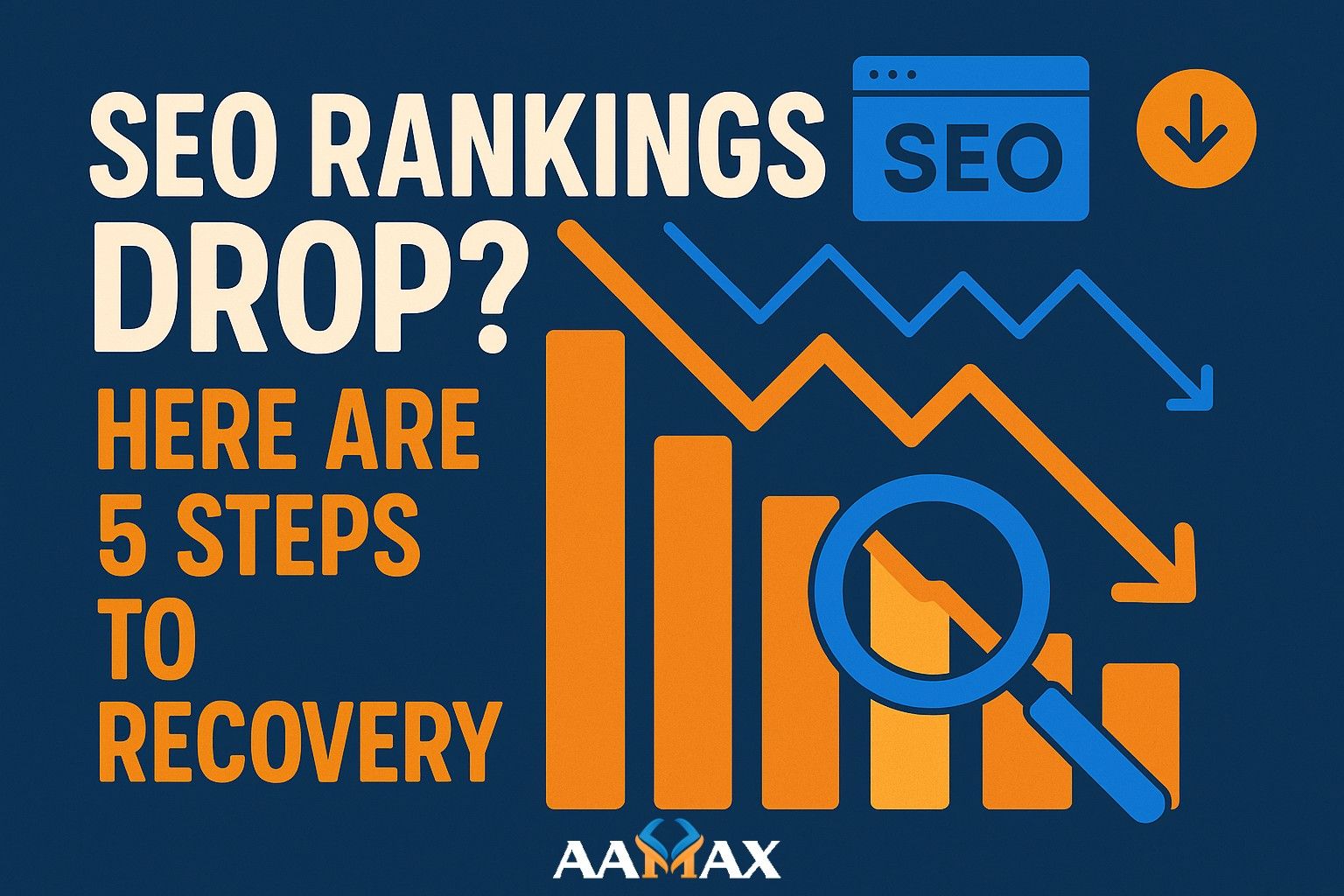
SEO Rankings Drop? Here Are 5 Steps to Recovery
One of the most frustrating experiences for website owners and marketers is seeing a sudden drop in SEO rankings. After months or even years of consistent work, slipping from the top pages of Google can feel overwhelming. Whether your rankings fell because of an algorithm update, technical issues, or competition, the good news is that recovery is possible with the right approach.
In this in-depth guide, we’ll walk you through five proven steps to recover from a rankings drop, rebuild your search visibility, and prevent future declines. By the end, you’ll understand how to identify the cause, take corrective action, and establish a sustainable Search Engine Optimization (SEO).
Why Do SEO Rankings Drop?
Before jumping into recovery, it’s essential to understand why rankings fall in the first place. Some of the most common reasons include:
- Google Algorithm Updates – Search engines frequently update their ranking criteria. A site that was once compliant may no longer align with new quality standards.
- Technical Issues – Problems like broken links, slow loading speeds, server errors, or improper indexing can hurt visibility.
- Content Quality Decline – Outdated, duplicate, or low-quality content may reduce your site’s authority.
- Increased Competition – New competitors or existing competitors improving their SEO can push your pages down.
- Backlink Issues – Toxic or lost backlinks can reduce domain authority.
- User Experience (UX) Issues – Poor site structure, high bounce rates, and mobile usability problems impact rankings.
The key to recovery lies in diagnosing the problem and systematically addressing it.
Step 1: Diagnose the Cause of the Drop
The first and most crucial step in SEO recovery is understanding why your rankings dropped. Without a clear diagnosis, any action you take might be wasted effort.
Tools to Use
- Google Search Console (GSC): Check for manual penalties, crawl errors, and indexing issues.
- Google Analytics: Review traffic trends to determine which pages or keywords lost rankings.
- SEO Tools (Ahrefs, SEMrush, Moz): Identify lost backlinks, keyword shifts, or content gaps.
Questions to Ask
- Did the drop coincide with a known Google algorithm update?
- Are specific pages affected, or is the entire site impacted?
- Did you lose high-quality backlinks recently?
- Has your site slowed down or faced server issues?
Action Tip: Create a benchmark report comparing rankings, traffic, and backlinks before and after the drop. This will help you pinpoint the root cause.
Step 2: Fix Technical SEO Issues
Search Engine Optimization problems are among the most common culprits behind ranking drops. Even a small error in site configuration can prevent Google from crawling and indexing your content properly.
Key Areas to Audit
-
Crawlability & Indexing
- Use GSC to ensure important pages are indexed.
- Fix robots.txt or noindex tag errors.
- Submit an updated XML sitemap.
-
Website Speed & Core Web Vitals
- Optimize images and enable browser caching.
- Use a Content Delivery Network (CDN).
- Fix CLS (Cumulative Layout Shift) and LCP (Largest Contentful Paint) issues.
-
Mobile Friendliness
- Test your site using Google’s Mobile-Friendly Test.
- Ensure buttons, forms, and menus are easy to use on small screens.
-
Broken Links & Redirects
- Identify 404 errors and fix them with redirects.
- Avoid redirect loops and chains.
-
HTTPS & Security
- Ensure your site has a valid SSL certificate.
- Fix mixed content warnings.
Action Tip: Use tools like Screaming Frog or Sitebulb to run a full technical audit and resolve errors quickly.
Step 3: Improve and Refresh Content
Content remains the foundation of SEO success, and Google prioritizes high-quality, relevant, and updated content. If your content hasn’t been updated in months (or years), this could explain your rankings drop.
How to Refresh Content
- Update Statistics & Facts: Ensure your information is current and accurate.
- Expand Thin Content: Add more value by covering related subtopics, FAQs, and insights.
- Optimize for Keywords: Naturally integrate long-tail keywords, synonyms, and semantic phrases.
- Add Visuals: Infographics, videos, and images make content engaging and shareable.
- Improve Readability: Use short paragraphs, headers, and bullet points for better UX.
Content Types That Perform Well
- Case studies
- Industry guides
- Comparison posts
- Video tutorials
- Infographics
Action Tip: Use tools like Surfer SEO or Clearscope to optimize your content against competitors’ top-ranking pages.
Step 4: Strengthen Your Backlink Profile
Backlinks remain one of the most influential ranking factors in SEO. If your rankings dropped because you lost valuable links or were penalized for toxic ones, you’ll need to take immediate action.
Steps to Recover Backlinks
- Audit Your Link Profile: Use Ahrefs or SEMrush to identify lost or toxic backlinks.
- Disavow Toxic Links: Submit a disavow file in GSC for harmful, spammy backlinks.
- Rebuild Lost Links: Reach out to websites that previously linked to you and request reinstatement.
- Earn New High-Quality Links:
- Guest post on reputable industry blogs.
- Publish data-driven research or reports.
- Collaborate with influencers and industry partners.
Action Tip: Prioritize quality over quantity. A few authoritative backlinks can be more impactful than dozens of low-quality ones.
Step 5: Monitor, Adapt, and Build for the Long Term
SEO recovery doesn’t happen overnight. It’s a process that requires monitoring and adapting as search engine algorithms evolve.
Best Practices for Long-Term SEO Health
- Track Rankings & Traffic Weekly: Use SEO tools and dashboards to monitor improvements.
- Stay Updated on Algorithm Changes: Follow industry blogs like Search Engine Journal and Google’s Search Central.
- Diversify Traffic Sources: Don’t rely solely on Google—use social media, email marketing, and paid ads.
- Focus on E-E-A-T (Experience, Expertise, Authoritativeness, Trustworthiness): Ensure your website content and structure demonstrate credibility.
Action Tip: Document your SEO recovery process and create a repeatable framework to use if future drops occur.
Pro Tips to Prevent Future SEO Drops
- Regularly perform site audits to catch technical errors early.
- Continuously update content to maintain freshness.
- Build a diverse backlink profile to avoid over-reliance on a single source.
- Invest in user experience and design to improve engagement metrics.
- Align SEO with business goals and audience needs to ensure long-term value.
Why Partner with Experts for SEO Recovery?
Recovering from an SEO services drop can be time-consuming and complex. From diagnosing technical errors to rebuilding content and backlinks, it requires a combination of skills and expertise. Partnering with professionals can help you recover faster and build a stronger foundation for future success.
That’s where AAMAX comes in. As a full-service digital marketing company, AAMAX specializes in web development, SEO, and digital marketing services tailored to your business needs. Their team helps businesses diagnose ranking issues, recover effectively, and implement long-term strategies that ensure sustainable growth.
Final Thoughts
A sudden SEO rankings drop can feel discouraging, but it doesn’t have to mean the end of your online visibility. By following these five steps—diagnosing the cause, fixing technical issues, refreshing content, strengthening backlinks, and monitoring consistently—you can recover your rankings and even surpass your previous performance.
Remember, SEO is a long-term game. Consistency, adaptability, and proactive efforts are what separate successful websites from those that fade into obscurity. By investing in recovery strategies and expert support, you’ll ensure that your business thrives in the ever-changing digital landscape.







